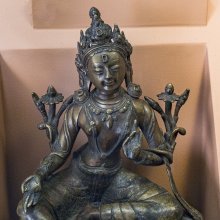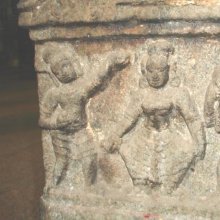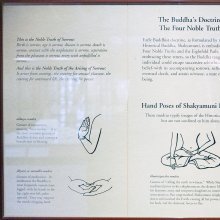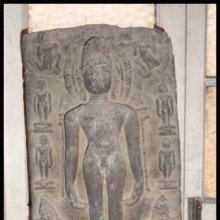Falling: 2 definitions
Introduction:
Falling means something in Hinduism, Sanskrit, the history of ancient India. If you want to know the exact meaning, history, etymology or English translation of this term then check out the descriptions on this page. Add your comment or reference to a book if you want to contribute to this summary article.
Images (photo gallery)
(+2 more images available)
In Hinduism
Natyashastra (theatrics and dramaturgy)
Source: Shodhganga: Elements of Art and Architecture in the Trtiyakhanda of the Visnudharmottarapurana (natya)Falling is associated with Kartarīmukha-hasta: one of the twenty-two Single-hand Gestures (in Indian Dramas) (known as asaṃyuktahastas), according to the Viṣṇudharmottarapurāṇa, an ancient Sanskrit text which (being encyclopedic in nature) deals with a variety of cultural topics such as arts, architecture, music, grammar and astronomy.—The word kartarī means scissor and along with the word mukha, it means mouth of the scissor. [...] Some activities like traveling, cutting and falling are projected with this hand gesture.

Natyashastra (नाट्यशास्त्र, nāṭyaśāstra) refers to both the ancient Indian tradition (shastra) of performing arts, (natya—theatrics, drama, dance, music), as well as the name of a Sanskrit work dealing with these subjects. It also teaches the rules for composing Dramatic plays (nataka), construction and performance of Theater, and Poetic works (kavya).
India history and geography
Source: Singhi Jain Series: Ratnaprabha-suri’s Kuvalayamala-katha (history)Falling (to the ground) (of birds) represents a scene of animal life commonly depicted on the Saṃsāracakra paintings, in ancient India, as mentioned in the Kathās (narrative poems) such as Uddyotanasūri in his 8th-century Kuvalayamālā (a Prakrit Campū, similar to Kāvya poetry).—Page 185.21 f.: Here follows a description of a printed scroll illustrating the Jaina conception of saṃsāracakra. [...] The saṃsāra-cakra illustrated the three worlds of hell, human world and the world of gods. [For example:] [...] A bird of prey falling to the ground was caught by a wild cat which in turn was attacked by a wild boar.

The history of India traces the identification of countries, villages, towns and other regions of India, as well as mythology, zoology, royal dynasties, rulers, tribes, local festivities and traditions and regional languages. Ancient India enjoyed religious freedom and encourages the path of Dharma, a concept common to Buddhism, Hinduism, and Jainism.
See also (Relevant definitions)
Full-text (+1338): Nipata, Nipatana, Cyuti, Patana, Ulka, Skhalana, Bhramsha, Nipatin, Prapatana, Pakshapata, Sampata, Samplava, Caranapatana, Vahabhramsh, Vinipata, Sramsin, Samnipata, Sampatin, Patayalu, Cyavana.
Relevant text
Search found 360 books and stories containing Falling; (plurals include: Fallings). You can also click to the full overview containing English textual excerpts. Below are direct links for the most relevant articles:
Vinaya Pitaka (4): Parivara (by I. B. Horner)
1.3. Monks’ Analysis: on Falling Away
2.3. Nuns’ Analysis: on Falling Away
Rig Veda (translation and commentary) (by H. H. Wilson)
Yoga Vasistha [English], Volume 1-4 (by Vihari-Lala Mitra)
Chapter CXI - The flight of the soldiers on all sides < [Book VII - Nirvana prakarana part 2 (nirvana prakarana)]
Chapter XC - Description of the watery creation < [Book VII - Nirvana prakarana part 2 (nirvana prakarana)]
Chapter XXXV - Description of the battlefield < [Book III - Utpatti khanda (utpatti khanda)]
Gobhila-grihya-sutra (by Hermann Oldenberg)
Listening to the Dhamma (by Nina van Gorkom)
Chapter 4 - The Stages Of Insight
Chapter 5 - The Objects Of Insight
Khadira-grihya-sutra (by Hermann Oldenberg)
Related products
(+25 more products available)











